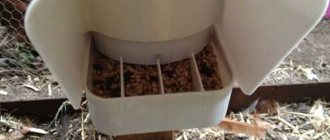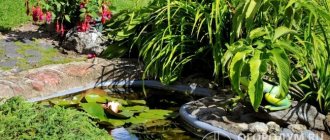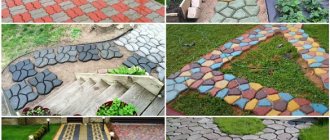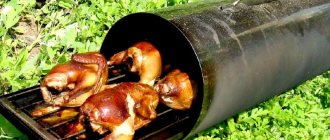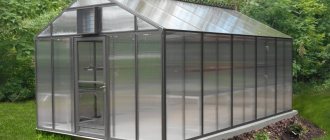It is very important to provide chickens with sufficient clean and fresh water in a timely manner. Proper watering of chickens contributes to better processing of food and, consequently, increased egg production in laying hens and increased weight in meat breeds of chickens.
To ensure that your birds always have clean and fresh water, it is necessary to provide the house with a good drinking bowl. The stores offer a large number of options, both for large farms and for private farmsteads.
It’s clear with stores - I came, bought, installed. But what if there are not enough funds or it is simply impractical to install purchased watering systems due to the small number of livestock? In this article we will look at several options for making drinking bowls for chickens with our own hands. First of all, it’s worth finding out what types of drinkers exist.
Types of drinking bowls
Drinking systems are classified into:
- Nipple;
- Cup;
- Vacuum (or siphon);
- Simple water containers.
Simple open drinking containers
It’s clear with simple drinkers - these are, as a rule, various basins, buckets, bowls, bowls made of plastic, galvanized or enameled iron.
Such drinking containers have a lot of disadvantages. Firstly, chickens can easily knock them over, thereby leaving the entire flock without water. Secondly, birds are constantly swarming, and the water in such drinking bowls will always be dirty, with garbage and droppings, so it will have to be changed several times a day.
It is advisable to use ordinary open containers as drinking bowls for chickens. For example, for daily allowances, you can put a saucer, place a jar in the center (so that they cannot climb into the container) and pour water. You just need to make sure they don’t spill water - wet chickens can die from hypothermia.
Vacuum
Such drinkers are also called siphon drinkers. They are optimal for a small flock of chickens (about 10-12 birds). The principle of operation is quite simple - water in a container under pressure does not pour out, but is kept in a vacuum. In general, it’s easier to show how such a drinking bowl works.
Making a homemade vacuum drinker is quite simple. Water is poured into the container, then a saucer or not very deep bowl is placed on top of the neck (for example, if it is a glass jar) on small wooden spacers. After this, the container is turned over. At first a little water will flow out, but then it will stop flowing. The water will fill the bowl as it is used.
By the way, in stores you can find a special bowl for such a drinking bowl. A recess has already been made in it. All that remains is to pour water into the container.
The disadvantage of this watering system is that chickens can easily turn the container over. Therefore, sometimes a finished product can be a good option. They are inexpensive. The option with legs is especially good - it is more stable.
Photo: store-bought vacuum drinker
Cup
It is difficult to assemble such a system with your own hands; it is better to buy a ready-made one. The design of drinkers for chickens of this type is quite simple: a cup and a tongue with a valve are attached to the base. The tongue is on the surface of the water and, as it decreases, it opens the valve, after which the water again fills the cup to the required level.
Sample of a drinking cup
On top of the entire structure there is an adjusting screw that allows you to adjust the water level in the cup. Water enters through a fitting to which a hose is connected. The other end of the hose is connected to a container of water.
Nipple
Such drinkers are also called drip drinkers. The principle of operation is simple: water enters a PVC pipe into which nipples are screwed in at a certain distance. Water flows into this pipe from some container, for example, a plastic canister, installed at a level above the structure. In essence, it turns out to be an automatic drinker; all that remains is to add water to the container.
Nipple drinker for chickens
Many novice poultry farmers often ask which drinking bowl is better. We answer: nipple (drip) is perhaps the most reliable and effective. It can be installed in open areas, in poultry houses, in chicken cages. But to make it at home you will need time, some parts and tools. We have dedicated a separate article to this chicken watering system: which will help you learn everything about drip drinkers for chickens.
Briefly about the main thing
There are many designs that can provide chickens with fresh drinking water. The optimal choice would be options that are sustainable, safe and easy to use. Thrifty owners strive to make a drinker themselves, and nipple, vacuum and siphon varieties, as well as products made from PVC pipes, are suitable for this.
The nipple design is the most difficult to manufacture, but it works automatically and is capable of providing drinking water to a large number of birds. The simplest is the vacuum system, which is ideal for chickens.
Ratings 0
Height of chicken drinkers
This parameter plays a very important role. Drinkers must be installed at a height that corresponds to the age of the bird. More details in the photo:
Important! Before assembling the waterer and installing it, keep in mind that the chickens should reach for water. This allows the liquid to freely enter the bird's crop.
[ads-pc-1] [ads-mob-1]
Forced replenishment
On the detailed drawings and photos of drinking bowls made by yourself, you can carefully examine all the nuances of the work on making a quality item. With the help of natural pressure in the water storage, the liquid container is able to replenish itself if a certain level is maintained.
In order to equip drinkers with automatic water supply, you need to perform more complex manipulations and use nipple dispensing technology. Due to their practicality, these models are very popular among true connoisseurs of truly high-quality devices.
Winter drinking bowls for chickens. Some useful ideas and examples
Heated drinking bowls are relevant for poultry houses that are not heated in winter. Water can freeze in sub-zero temperatures, and the chickens will be left without water.
You can, of course, bring the container in after each meal and take it out with fresh, slightly warmed water for a new one. And this is the last option if there is no electricity in the chicken coop (you can use various long-lasting candles, but an open fire in a poultry house is very dangerous).
If there is electricity, then we will show you how to easily and simply make a warm drinking bowl yourself, and in several options, and in winter your chickens will always be provided with clean and fresh drink.
Do-it-yourself winter drinking bowl from an ordinary light bulb
We found this idea on the website detikukuruzy.ru (photo from the same place). The principle is very simple: an ordinary incandescent lamp is installed in a metal box. A small hole is left at the top of the box. Next, the drinker is placed on this box.
The heat coming from the light bulb prevents the water from freezing. No way to make a box? Then here's a simpler option:
The light bulb is mounted inside a cinder block (or foam block) and a drinking bowl is placed on it.
There is also an option from a gift tin box. The principle is the same:
The cartridge is mounted
Drinker for winter: option with heating cable
To heat the water in the drinking bowl, you can use a heating cable, which is used when installing heated floors. Such a cable can be bought in hardware stores and they sell it there by the meter.
We wrap the drinking bowl container (in the case in the photo above it is a nipple one), thoroughly insulate all connections and connect it to the network.
Heating the vacuum drinker with a heating cable
Using a heating cable you can easily provide automatic heating. For this purpose, a special unit is purchased that regulates switching on and off. When the water cools to a certain temperature, the cable will begin to heat it to the optimal temperature. This is an expensive option, but is applicable for large numbers of chickens.
Non-freezing drinking bowl
It sounds pretentious, of course, because unheated water will still freeze at sub-zero temperatures, but there is still a method. It is especially relevant in cold weather, when the temperature outside is about -10 degrees.
The whole point is to place the drinking bowl container in another larger container and fill the space between the two containers with polyurethane foam.
Description
Studying the design of a nipple drinker will allow you to understand how it works. The system intended for chickens consists of several parts:
- water supply hose;
- a round or square pipe connected to it;
- nipples.
A filter may be provided, thanks to which small particles will no longer enter the water - this will prevent clogging of the system and the occurrence of leaks. Water is supplied from:
- tank - the container is attached 10-30 cm above the level of the pipe, the duration of the liquid entering the pipe depends on its size, it will have to be filled periodically;
- water supply - the liquid is supplied automatically; when connecting, it is necessary to provide a pressure regulator (with high pressure, leaks cannot be avoided).
The drinking nipple is a simple device, similar in design to a hand washstand. It consists of a fixed part and a movable rod. The larger its diameter, the larger the droplet formed.
Nipples are divided into 2 groups:
- 180 degrees - the rod rises and falls, which is why the drinker is suitable only for adult chickens; it is difficult for young animals to drink from it;
- 360 degrees - the rod can move in any direction (vertically and horizontally), it is easy for chickens to move it and get a portion of water.
180 degree nipples are not recommended for installation in pipes with a diameter exceeding 25 mm. If there is a strong impact, the moving part may get inside, and water will flow in a stream onto the floor of the chicken coop. There is no such problem in the 360-degree design - the moving part returns to its place thanks to the spool. This model costs more, but only this nipple drinker is suitable for broiler chickens and other breeds.
The operating principle, based on the design, is as follows:
- water flows into the pipe on which the nipples are installed;
- the bird uses its beak to move the movable “tongue” up or to the sides;
- the hole opens slightly and a drop of water flows down;
- after the impact ceases, the rod returns to its place and closes the hole.
Since a small amount of liquid will still fall onto the floor when drinking, it is recommended to install hanging cups under the nipples to catch drips.
Homemade drinking bowls for chickens from sewer pipes
From a plastic pipe that is used for sewage, you can make quite reliable and effective wall-mounted drinking bowls with your own hands. Such devices are convenient not only for chickens, but also for their owners, since they are easy to fill and drain water, as well as clean and wash.
What you will need
- Drill or screwdriver with drill bit;
- An electric jigsaw or a hacksaw file;
- Plastic sewer pipe (length at your discretion);
- Two 90 degree bends or two plugs instead;
- Two fastenings;
How to make a homemade chicken drinker from a plastic pipe: step-by-step description of the process
Draw a straight line along the entire length of the pipe. Holes will be cut along this line. Draw the outline of future holes with a marker. They should be oval, approximately 20-30 cm long.
We drill a hole with a drill so that the file from the jigsaw can move freely in it.
Cut it out.
Now all that remains is to secure the drinker to the wall using fasteners. The ends of the pipe can be plugged or elbows inserted into them, through which water can be easily drained and filled.
Do not forget to sand the edges of the cut holes so that the birds do not get hurt.
The hanging drinking bowl for chickens from the sewer pipe is ready.
Requirements for the reservoir
First of all, chicken watering must meet certain criteria in order to maintain the health of the animals, their normal growth and longevity.
- Safety. Consideration should be given to ensuring that the chicken cannot be injured by protruding parts or sharp edges. When making a drinking bowl for chickens with your own hands, you need to choose a safe material that will not form compounds that are dangerous to the health of the animal.
- Reliability and stability. A drinking bowl installed in a cage or aviary may arouse the bird's interest and end up overturned by accident or as a result of an attack. Therefore, it is necessary to make the container from a material that has a margin of safety, and also securely fasten it in the cage.
- Ease of use. A bird drinker must be designed in such a way that it is easy for the bird to get to drink, and it can be filled without problems; fill it with water or, for example, connect a water supply.
- Purity. Various microorganisms can multiply in water, which is dangerous for birds. Therefore, the drinking bowl must be protected from any debris.
Automatic water supply to drinking bowls from pipes
A homemade version made from a nipple, a wine bottle cork, a metal plate and wire.
Another idea is to make your own automatic waterer for chickens. The fittings from the toilet cistern are used. Water is supplied through a hose.
Important nuances
Why do you need a drinker?
Chickens need to drink enough fluids daily. The volume of water required depends on the age of the birds, time of year, and food.
To avoid dehydration, the average chicken needs to drink at least 250-300 milliliters of water per day.
If you use ordinary troughs with water, the bird will constantly douse itself and walk around wet. The optimal solution is to install an automatic drinker.
This device ensures that water is supplied only at the right moment, when the chicken comes up to drink. This will keep the birds and bedding dry.
Main pros and cons
The design has several advantages:
- the liquid is not contaminated with feathers, food and excrement;
- chickens will not be able to turn over the sippy cup and spill water on the litter;
- it is possible to water a large number of birds at once;
- water is supplied in portions, so pathogenic bacteria do not have time to develop in the container.
Automatic drinkers for chickens also have disadvantages. Purchased options are high-quality and reliable, but require financial costs. And homemade structures can break.
In addition, if the device is not heated, in winter, during severe frosts, the water in them will freeze. But there is a way out, which is described below.
Device requirements
Automatic waterers for chickens and hens are a necessary device in a chicken coop. Therefore, they must be of high quality, comfortable and safe. Another important property is lightness, otherwise if the device accidentally falls, it can injure the chicken.
A high-quality automatic drinker has reliable fastenings. In this case, you won’t have to constantly look after her. And the chickens will not be able to overturn the structure if they create a pandemonium at the watering hole.
The optimal material is plastic. It is lightweight and washes off dirt well. Make sure that the structure does not have sharp corners, otherwise the birds will get hurt.
It will be more convenient if the device’s functions include automatic filling from the water supply. The birds will not be left without water, even if the farmer forgets about the drinking bowl.
Difference between waterers for chicks and chickens
When choosing automatic drinkers, you need to take into account the age of the chickens.
The chicks need a low device so they can reach it. The design must operate when moving in all directions.
For adult chickens, a standard-sized waterer that works downwards and upwards is suitable.
Sippy cups made from plastic bottles
You can make a drinking bowl for chickens in a few minutes from available materials, for example, from plastic bottles.
The simplest option: in a five-liter bottle, at a distance from the bottom, cut several round holes in a circle. The holes should be such that the bird can freely stick its head in and drink. The bottle can be hung or attached to the wall.
Sippy cup from a regular 1.5 liter bottle:
Vacuum drinking bowl from a plastic bottle and container:
Simple designs
Having a bucket available, you can make a temporary drinking bowl while the main structure is under development. As a basis, take a pallet from a flower vase; it is quite heavy and stable.
It is worth remembering that its size should be slightly larger than the container itself, otherwise the stability effect will not be achieved. The liquid from the bucket will gradually accumulate in the pan and the birds will be able to easily quench their thirst.
When the tank runs out of water, it will need to be replenished manually; this moment cannot be missed. Thanks to the advice received, you can achieve pretty good results and provide yourself not only with eggs and meat, but also with plenty of free time to garden or communicate with loved ones.
Step by step instructions
So, a homemade automatic feed container should be designed in such a way that it can be easily secured to the wall using hinges. If you have a large enough flock of birds, then the capacity of the bunker should be approximately 10 kilograms. Our dry food container will have the following dimensions:
- length – 50 centimeters;
- width with footrest – 32 centimeters;
- the working cavity is 50 long, 6 wide and 3.5 centimeters high.
So, we have the materials, let's get to work:
- From small boards we make the frame of the main bunker and a separate pull-out tray.
- We cover the frame with 10 mm plywood.
- We make access barriers from small pieces of tin, as seen in the photo.
Drawing of homemade wooden feeders for pigeons. You can also see in more detail and clearly what the feeders look like in the presented video.




